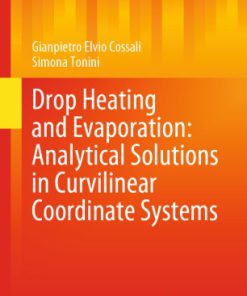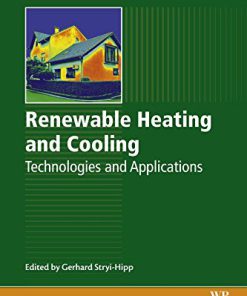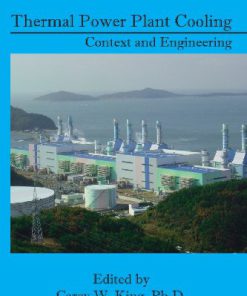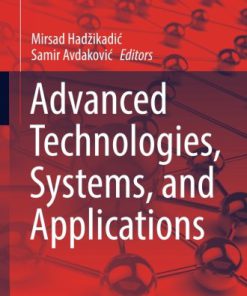Advanced District Heating and Cooling (DHC) Systems 1st Edition by Wiltshire 1782423958 9781782423744 9781782423959
$50.00 Original price was: $50.00.$25.00Current price is: $25.00.
Advanced District Heating and Cooling (DHC) Systems 1st Edition by Wiltshire – Ebook Instant Download/Delivery ISBN(s): 9781782423744, 9781782423959, 1782423958
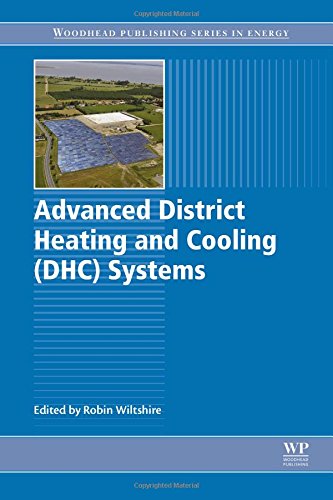
Product details:
- ISBN 10: 1782423958
- ISBN 13: 9781782423744 9781782423959
- Author: Wiltshire
Advanced District Heating and Cooling (DHC) Systems presents the latest information on the topic, providing valuable information on the distribution of centrally generated heat or cold energy to buildings, usually in the form of space heating, cooling, and hot water.
As DHC systems are more efficient and less polluting than individual domestic or commercial heating and cooling systems, the book provides an introduction to DHC, including its potential contribution to reducing carbon dioxide emissions, then reviews thermal energy generation for DHC, including fossil fuel-based technologies, those based on renewables, and surplus heat valorization. Final sections address methods to improve the efficiency of DHC.
Table of contents:
1: Historical development of district heating and characteristics of a modern district heating system
Abstract
1.1 Introduction
1.2 Characteristics of a modern district heating system
1.3 Organisational aspects
1.4 Summary
2: District heating and cooling policies worldwide
Abstract
2.1 Introduction
2.2 Issues for discussion
2.3 European Union
2.4 Other Europe an countries
2.5 China
2.6 Other Asian countries
2.7 Russia
2.8 North America
Part Two: Energy sources and plant technologies
3: Cogeneration, biomass, waste to energy and industrial waste heat for district heating
Abstract
3.1 Introduction
3.2 Thermal energy production by fossil fuel boiler plants for district heating
3.3 CHP produced by engines for district heating
3.4 Large CHP plants for district heating
3.5 Biomass and biogas for district heating
3.6 Waste to energy for district heating
3.7 Using industrial waste heat for district heating
3.8 Conclusion
3.9 Future trends
3.10 Sources of further information
4: Deep geothermal energy for district heating: lessons learned from the U.S. and beyond
Abstract
4.1 Introduction
4.2 Technological overview of the use of deep geothermal energy for district heating
4.3 Advantages and challenges of deep geothermal for district heating
4.4 Modeling of deep geothermal district heating systems
4.5 Case studies
4.6 Future trends
4.7 Sources of further information
5: Solar thermal energy for district heating
Abstract
Acknowledgment
5.1 Introduction
5.2 Technology overview of solar thermal plants for district heating
5.3 Economics
5.4 Future trends
5.5 Sources of further information
6: Energy sources for district heating and cooling
Abstract
6.1 Background
6.2 Energy selection priorities
6.3 Energy sources
6.4 Considerations in the use of localized energy
6.5 Energy project examples
6.6 Future trends
7: Energy storage for district energy systems
Abstract
7.1 Introduction
7.2 What is thermal energy storage?
7.3 Centralized/decentralized long-term (seasonal) storage used in large scale district energy systems
7.4 Heat production optimization
7.5 Design parameters and operational principles
7.6 Operational schemes (control regimes)
7.7 Charging and discharging of directly connected TES
7.8 Charging and discharging of a pressure separated TES
7.9 Designing a thermal store
7.10 Seasonal thermal storage
Case studies
8: District cooling, current status and future trends
Abstract
8.1 Introduction
8.2 Technological overview of typical district cooling system
8.3 Central plant configurations
8.4 Chilled water distribution systems
8.5 Building interconnections
8.6 Improving system performance
8.7 Deep water ‘free cooling’ systems case studies
8.8 Future trends
8.9 Ball State University case study
Part Three: Component development, operational efficiency improvement and planning
9: New developments in pipes and related network components for district heating
Abstract
9.1 Introduction
9.2 Drivers for development
9.3 Pipes
9.4 Joints
9.5 Other components
9.6 Installation methods and excavation work
9.7 Future trends
9.8 Sources of further information
10: New developments in substations for district heating
Abstract
10.1 Introduction
10.2 Specification of modern district heating substation
10.3 Interactions with a modern district heating substations
10.4 Standardization of a district heating substations
10.5 Developments in substation components
10.6 Future trends
11: Temperature optimization in district heating systems
Abstract
11.1 Introduction
11.2 The connection between district heating temperatures and different parts of the district heating system
11.3 Temperature optimization in district heating systems
11.4 Future trends
11.5 Sources of further information
12: District heating monitoring and control systems
Abstract
12.1 Introduction
12.2 Substation architecture
12.3 Control principles
13: Prediction and operational planning in district heating and cooling systems
Abstract
13.1 Introduction
13.2 District heating and cooling system
13.3 Thermal load prediction in district heating and cooling systems
13.4 Operational planning of a district heating and cooling plant
13.5 Conclusion
Part Four: Business models and urban planning for heat networks
14: Business models for district heating
Abstract
14.1 Introduction
14.2 A business model framework
14.3 The business logic of district heating
14.4 Business models on the Swedish market
14.5 Discussion
14.6 Conclusion
15: Development of district heating and cooling in the urban planning context
People also search:
advanced heating technology
advanced heating and cooling new albany ms
advanced heating bremerton
advanced heating services
advanced heating and air aberdeen wa
You may also like…
Engineering
Advanced Thermoelectrics: Materials, Contacts, Devices, and Systems 1st Edition Zhifeng Ren
Mathematics
Housekeeping & Leisure - Interior Design & Decoration
Renewable heating and cooling technologies and applications 1st Edition Stryi-Hipp
Biography & Autobiography
Engineering - Mechanical Engineering & Dynamics
Thermal power plant cooling context and engineering 1st Edition Carey Wayne King
business
Absorption Heating Technologies Efficient Heating Heat Recovery and Renewable Energy Wei Wu
Engineering - Energy & Power Resources





